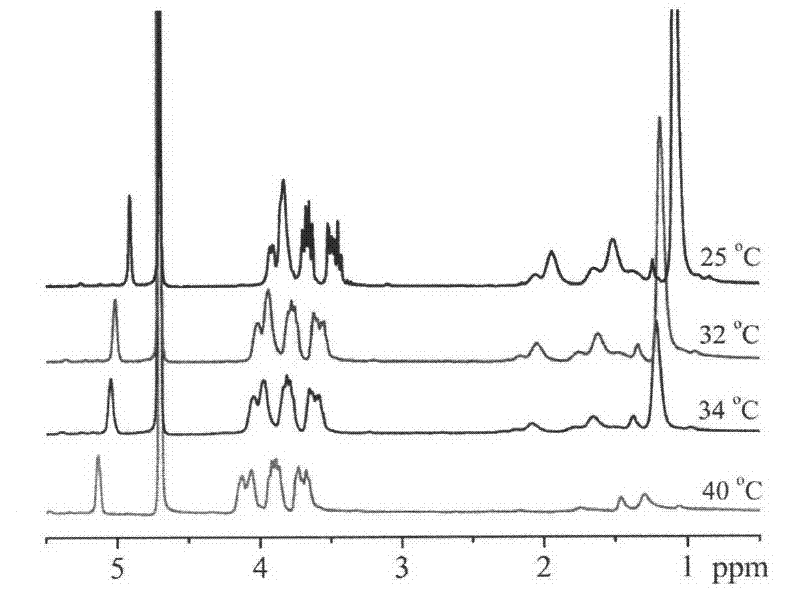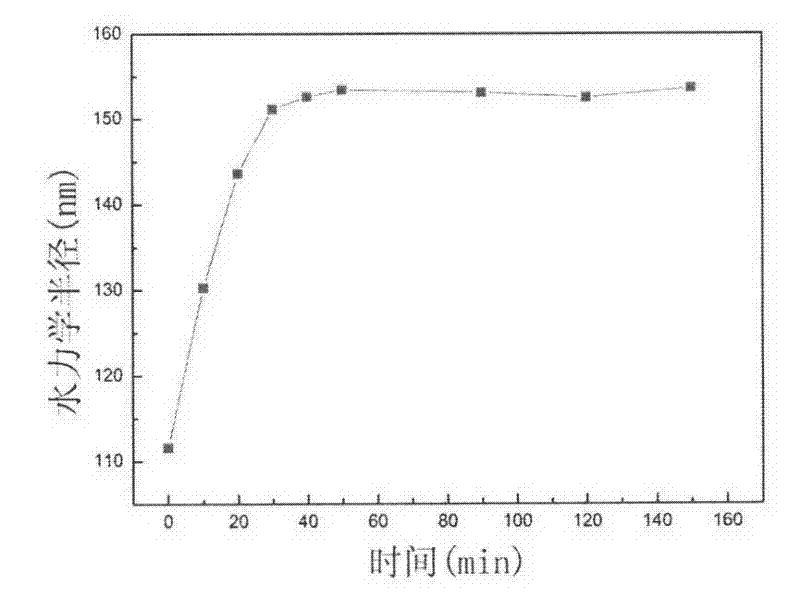Temperature and redox stimuli responsive nano-hydrogel and preparation method thereof
A nano-hydrogel and stimuli-responsive technology, applied in the field of functional polymer hydrogel materials, can solve the problems of polymer biodegradability and biotoxicity to be optimized, and achieve controllable molecular weight distribution, large application value, and relative The effect of large surface area
- Summary
- Abstract
- Description
- Claims
- Application Information
AI Technical Summary
Problems solved by technology
Method used
Image
Examples
Embodiment 1
[0027] First, dodecanethiol (12ml), acetone (40ml), and trioctylmethylammonium chloride (0.8ml) are fully mixed, and the solution is added to a 150ml three-necked flask, and the temperature of the solution is controlled at 5°C. Zhongtong N2 thirty minutes. NaOH (4 ml) with a mass fraction of 50% was added dropwise to the solution under nitrogen protection and stirring. After the dropwise addition, the reaction was carried out for 20 minutes. After the reaction, a mixture of carbon disulfide (3ml) and acetone (8ml) was added dropwise to the above solution, and the reaction was stirred for 30min. Then 50% NaOH (13ml) was added dropwise to the solution, after 12 hours of reaction at room temperature, 65ml of water was added, and finally 33ml of concentrated hydrochloric acid was added to obtain a yellow solid. The yellow solid was recrystallized 8 times with n-hexane to finally obtain a yellow flaky solid, which was the reaction product 2-dodecyldithiocarbonyl-2-methylpropionic...
Embodiment 2
[0033] The preparation of 2-dodecyltrithiocarbonyl-2-methylpropionic acid grafted dextran (DexDTM) is the same as in Example 1. Dissolve 0.2g of DexDTM in 40ml of deionized water, add 0.40g of isopropylacrylamide to the above solution, then add 0.08g of initiator VA-044, and react at 60°C for four hours. After the reaction, the solution is dialyzed for 3 days and then frozen. Dry the reaction product polyisopropylacrylamide grafted dextran, referred to as DexPNI. According to nuclear magnetic analysis, the average chain length of polymer-grafted polyisopropylacrylamide is 36.9.
[0034] Dissolve 50 mg of DexPNI in 10 ml of water, then add 0.1 ml of isopropylamine and 10 mg of dithiothreitol to the above solution under nitrogen protection, room temperature and stirring, and finally react at room temperature for 2 h to obtain SH-DexPNI. The resulting 5 mg / ml SH-DexPNI solution was reacted in an oxygen environment at 50° C. for 12 hours to finally obtain the polymer disulfide cr...
Embodiment 3
[0036] First, fully mix dodecanethiol (18ml), acetone (60ml), and trioctylmethylammonium chloride (1.2ml), control the solution temperature at 10°C, and pass N2 into the three-necked flask for 30 minutes. NaOH (4 ml) with a mass fraction of 50% was added dropwise to the solution under nitrogen protection and stirring. After the dropwise addition, react for 30 minutes. After the reaction, a mixture of carbon disulfide (5ml) and acetone (12ml) was added dropwise to the above solution, and the reaction was stirred for 30min. Then 50% NaOH (18ml) was added dropwise to the solution, after 12 hours of reaction at room temperature, 50ml of water was added, and finally 50ml of concentrated hydrochloric acid was added to obtain a yellow solid. The yellow solid was recrystallized eight times with n-hexane to finally obtain a yellow flaky solid, which was the reaction product 2-dodecyltrithiocarbonyl-2-methylpropionic acid-grafted dextran, referred to as DTM.
[0037] 0.6 g of DTM was ...
PUM
 Login to View More
Login to View More Abstract
Description
Claims
Application Information
 Login to View More
Login to View More - R&D
- Intellectual Property
- Life Sciences
- Materials
- Tech Scout
- Unparalleled Data Quality
- Higher Quality Content
- 60% Fewer Hallucinations
Browse by: Latest US Patents, China's latest patents, Technical Efficacy Thesaurus, Application Domain, Technology Topic, Popular Technical Reports.
© 2025 PatSnap. All rights reserved.Legal|Privacy policy|Modern Slavery Act Transparency Statement|Sitemap|About US| Contact US: help@patsnap.com



